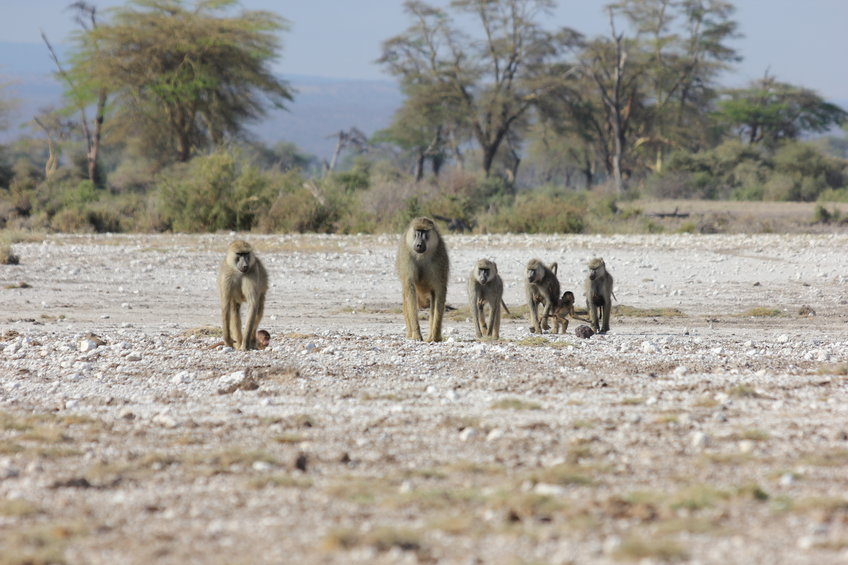Costs and benefits of genetic mixing
Baboons borrowed a third of their genes from a closely related species
New genetic analyses of wild baboons in southern Kenya reveals that most of them carry traces of hybridization in their DNA. As a result of interbreeding, about a third of their genetic makeup consists of genes from another, closely-related species. The researchers led by Jenny Tung from Duke University and now at the Max Planck Institute for Evolutionary Anthropology, measured genetic variation and gene activity to understand the possible costs and benefits of genetic mixing in primates, including humans.

The study took place in a region near Kenya’s Amboseli National Park, where yellow baboons occasionally meet and intermix with their anubis baboon neighbors that live to the northwest. Researchers have monitored these animals on a near-daily basis since 1971, noting when they mated with outsiders and how the resulting offspring fared over their lifetimes as part of the Amboseli Baboon Research Project, one of the longest-running field studies of wild primates in the world.
Yellow baboons have yellow-brown fur with white cheeks and undersides. Anubis baboons have greenish-grey fur and males with shaggy manes around their heads. Although they diverged 1.4 million years ago, they can hybridize where their ranges overlap. By all accounts, the offspring of these unions manage just fine. Fifty years of observations turned up no obvious signs that hybrids fare any worse than their counterparts. Some even fare better than expected: baboons that carry more anubis DNA in their genome mature faster and form stronger social bonds, and males are more successful at winning mates. But new genetic findings suggest that appearances can be deceiving.
High degree of genetic mixing
The research sheds light on how the diversity of species on Earth is maintained even when the genetic lines between species are blurry, said Duke University professor Jenny Tung, who led the project with her doctoral students Tauras Vilgalys and Arielle Fogel. Interspecies mating is surprisingly common in animals, said Fogel. Some 20 to 30 percent of apes, monkeys and other primate species interbreed and mix their genes with others. Even modern humans carry around a mix of genes from now-extinct relatives. As much as two to five percent of the DNA in our genomes points to past hybridization with the Neanderthals and Denisovans, ancient hominins our ancestors encountered and mated with as they migrated out of Africa. Those liaisons left a genetic legacy that still lingers today, affecting our risk of depression, blood clots, even tobacco addiction or complications from Covid-19.
The researchers wanted to understand the possible costs and benefits of this genetic mixing in primates, including humans. But modern humans stopped interbreeding with other hominins tens of thousands of years ago, when all but one species -- ours -- went extinct. The wild baboons of Amboseli, however, make it possible to study primate hybridization that is still ongoing. The researchers analyzed the genomes of some 440 Amboseli baboons spanning nine generations, looking for bits of DNA that may have been inherited from anubis immigrants. They found that all baboons in the Amboseli region of Kenya today are a mix, with anubis DNA making up about 37 percent of their genomes on average. Some have anubis ancestry due to interbreeding that occurred fairly recently, within the last seven generations. But for nearly half of them the mixing happened further back, hundreds to thousands of generations ago.
Effect on gene regulation
During that time, the data show that certain bits of anubis DNA came at a cost for the hybrids who inherited them, affecting their survival and reproduction in such a way that these genes are less likely to show up in their descendants’ genomes today, said Vilgalys, now a postdoctoral scholar at the University of Chicago. Their results are in line with genetic research in humans, which suggests that our early ancestors paid a price for hybridizing too — but one that is tough to tease out from the limited fossil and DNA evidence still available. The researchers say that the baboons at Amboseli offer clues to the costs of the hybridization. Using RNA sequencing to measure gene activity in the baboons’ blood cells, the researchers found that natural selection is more likely to weed out bits of borrowed DNA that act as switches, turning other genes on and off.
“The next step”, Fogel said, “is to pin down more precisely what is ultimately affecting these hybrid baboons’ ability to survive and reproduce.” Genomic data allows researchers to look back many more generations and study historical processes that can’t be seen directly in the field, “But you need to look at the animals themselves to understand what genetic changes actually mean,” Tung explained, now at the Max Planck Institute for Evolutionary Anthropology in Germany. “You need both fieldwork and genetics to get the whole story. We’re not saying that the case in baboons is equivalent to the case for Neanderthals, Denisovans, and humans. But the baboon case makes it clear that genomic evidence for costs to hybridization can be consistent with animals that not only survive, but often thrive.”












